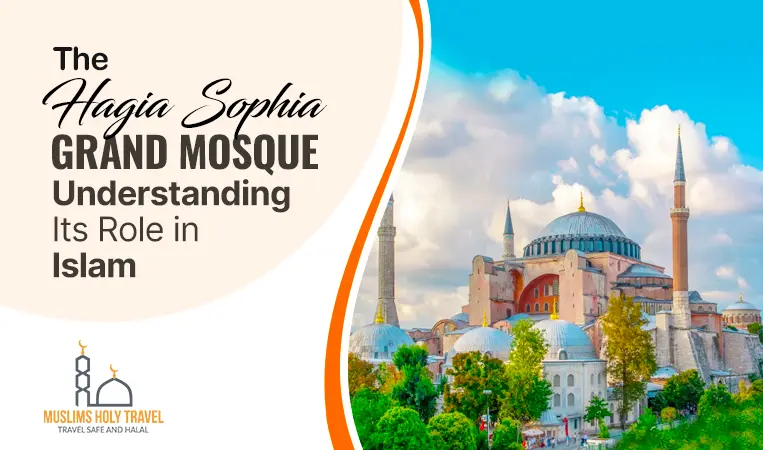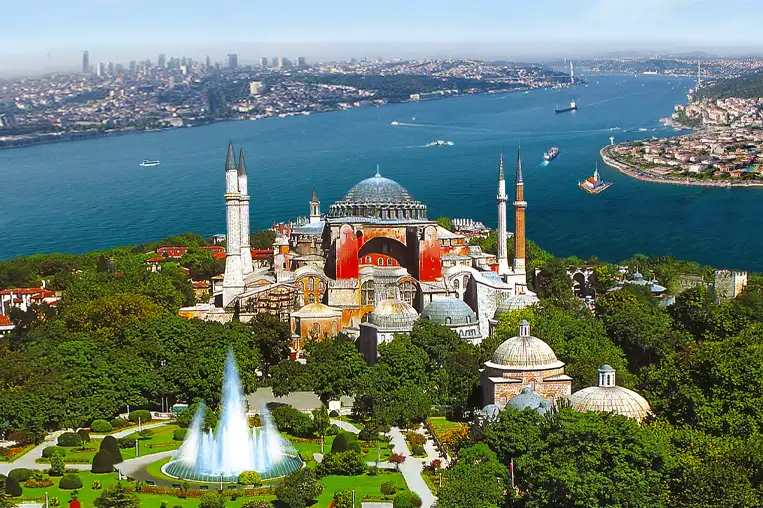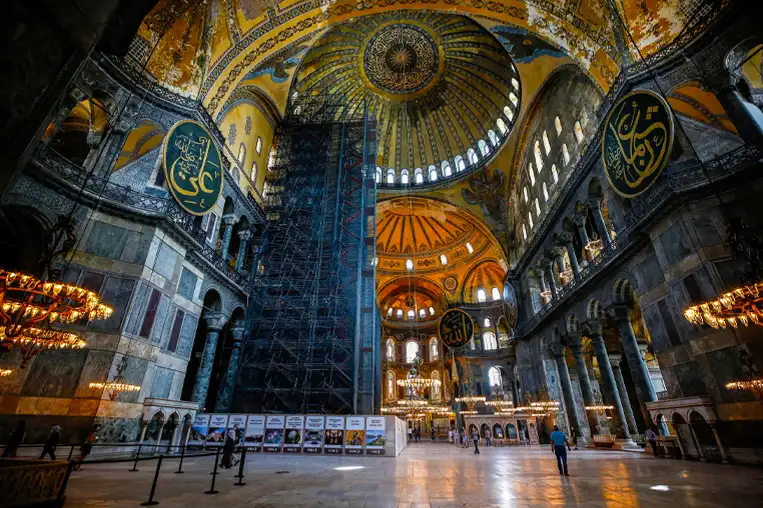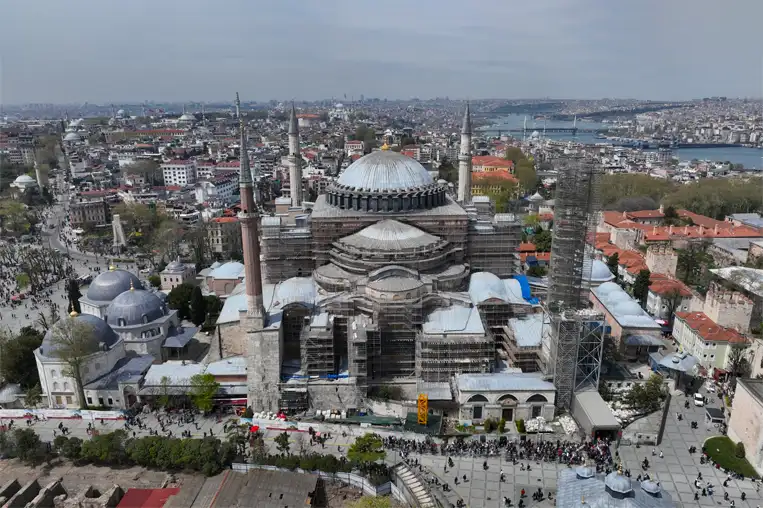
Hagia Sophia Grand Mosque is one of the most visited landmarks in Istanbul - Turkey, owing to its Islamic and architectural significance that earns a special spot in the hearts of Muslim travellers. The transformation story of this mosque is even more interesting and inspiring, showcasing its evolution from a Church (initially) to a mosque, then to a museum, and finally back to a mosque. This great mosque is famous with its Turkish name “Aya Sofya”, and serves as an embodiment of faith, culture, art, power, determination and identity. The powerful combo of Islamic and Christian heritage traces makes it central to both Istanbul’s majestic skyline as well as for religious and cultural discussions on a global scale. To understand its role in Islam, notably, it is pivotal to read about its significance in Islam, history, construction and architectural aspects, the timeline of key events here, as well as current updates and news on this mosque. We have assembled all these details in this thoughtful post to help you better comprehend the role of this special mosque in Islamic heritage. Let’s get to the point together!
Hagia Sophia serves as more than a mere historical monument for Muslims. What was built initially as a Church got converted into a fully functional mosque in 1453 by Sultan Mehmed II and this change became a central point for Islamic rituals and prayers. During this time, a few renovations were made into the mosque’s structure including the addition of minarets, a mihrab that points towards Makkah and a minbar. Over the years, the mosque symbolised Islamic power and strong presence in the region under the Ottoman Empire and was not only considered a place of worship but also as a statement of authority, faith and culture. Islamic calligraphy and symbols were also added to it while the Christian mosaics and icons were either covered or altered to comply with Islamic principles. The Turkish Republic secularised the building in 1934 and after that, turned it into a museum in 1935. In 2020, its status again got changed from a museum to a functional mosque and this reconversion was marked as an important achievement and golden moment for many Muslims who saw its restoration back to a mosque for religious use.

The Hagia Sophia Grand Mosque is considered a masterpiece due to its fine construction, mind-blowing aesthetics and precise engineering. The dome of the mosque appears a bit afloat due to the windows and base. The pendentives help distribute the weight of the dome onto the supporting piers. The building as a whole creates a sense of height, light and spaciousness. The overall building is made of special bricks, columns, marbles and decorative elements and the interior is richly adorned with mosaics, marble panels and alternating colours as well as light. The windows at the base of the dome let the light into the space and give a special luminous effect to the mosque.
Due to its age and location, the mosque’s structure suffered an extensive damage multiple times from earthquakes, fires and wear. Its dome completely collapsed in an earthquake in 558 and was later repaired. Other half domes were also damaged and later restored. Major building techniques were applied during the Ottoman period such as repairing cracks and adding support. During the 19th century, major restoration of the structure was successfully done by the Fossati brother who reinforced the structural weakness.
As a mosque, Hagia Sophia serves all the purposes expected from a functional mosque in Islam. Muslim prayers are conducted daily five times here. Other than this, Jummah congregational prayers, sermons or Khutbah and the communal gatherings of Muslims also take place here. The acoustics of the building allow the Adhan and recitation of the Holy Quran to carry smoothly in the large interior. Moreover, the open prayer space, carpets, areas of ablution and the well-distributed design enable a smooth worship for the Muslims with no hassle. Owing to the dual heritage nature of the mosque, efforts have been made to strike a balance between preserving Christian artwork and allowing Muslim worship. After its conversion to a mosque in 2020, the Christian mosaics were also preserved and visitors of all faiths can enter the mosque during the specified times while ensuring the worship here remains central.

Other than the current status as the Hagia Sophia Grand Mosque, the building serves several roles for Muslims beyond just being a place of praying. From the spiritual perspective, it is a place of congregational worship, salah, Ramadan observances and remembrance. Owing to its grandeur and history, Muslims feel a special connection while worshipping here as it is majorly linked to the Islamic history in a major empire as well as the expansion of the Muslim civilization. From the cultural perspective, this property stands as a testament of dual or shared heritage and its architecture, mosaics and grandeur inspired many other small mosques’ designs in the region. The mosque embodies how Islam can adapt and leave traces of earlier periods while transforming structures and helps bridge the gap between Christian and Islamic civilisations. Symbolically, the mosque represents the rise of Islam int eh Eastern Roman world during the Byzantine period, the power of the Ottomans, debates over secularism, faith, heritage and identity. It also stands as a symbol of the restoration of a historical Muslim worship place. The mosque thus remains relevant, not only for Turkish Muslims but globally and inspires conversations about what it means to preserve religious heritage for all faiths.
Though Hagia Sophia is loved in many quarters, its story also involves some controversies and challenges, and its preservation is one among such challenges. The age of the structure plus its continuous exposure to natural disasters like earthquakes, weather and structural stress from heavy domes as well as the wear of time do threaten its stability as a structure. Therefore, this raises the need for continuous restorations that must be done carefully while not causing any harm or change to the mosque’s original features like mosaics and decorative elements. As this is also a UNESCO World Heritage Site therefore international expectations of conservation are also a part of such efforts. Another great controversy of the time is the religious and political meaning of its status changes or transformation. While some see the reconversion to mosque as reclaiming of an Islamic legacy while some see it as marginalizing Christian heritage or upsetting multicultural norms. Numerous concerns therefore have been raised in this regard by religious leaders, UNESCO, and heritage organizations. In addition, the dual usage of this mosque as a tourist heritage site also involves logistical issues such as the continuation of worship without disturbing tourists, covering Christian elements during prayers, managing crowds, conservation, and safety while keeping everything authentic and a lot of efforts are being made in this regard by the management and government.
In recent years, the mosque has been in the news for several reasons such as its status, heritage preservation and restoration. As the building is nearly 1500 years old, therefore preserving this giant structure is a major challenge. In 2025, large-scale restoration efforts have begun, focusing mainly on the main dome and half domes. This includes reinforcing the entire structure for withstanding earthquakes, replacing the worn-out materials like lead and inspecting the underground structures. As Istanbul lies in the seismic zone therefore ensuring the safety of the structure remains crucial for the worshippers and visitors. The current status of the mosque as both a tourist destination and Muslim worship place brings in new challenges that spark international conversation and sometimes criticism. Additionally, the question of Waqf is relevant. The Hagia Sophia is considered a property under the Waqf law which means it is endowed for religious uses mainly and in some cases, for charitable causes as well, which gives it a legal framework in Turkish and Islamic law for its management and its use as a mosque.

The Hagia Sophia Grand Mosque stands out as a living story of faith and resilience. Each chapter of its transformation reveals something about how religion, culture, politics and identity intersect. From the Islamic perspective, it depicts the spiritual significance of places of worship and how Muslims over centuries have cared for such places.
If you are one among those interested in exploring the top landmarks of Islamic significance in Turkey and relevant destinations, look no further than US! We are an ATOL-protected and IATA-certified travel agency in the UK serving a wide range of Umrah packages with cultural tours to significant places on earth, including Turkey, the UAE, and other destinations. Got any questions? Send us an email at info@muslimsholytravel.co.uk and let’s talk about it!



